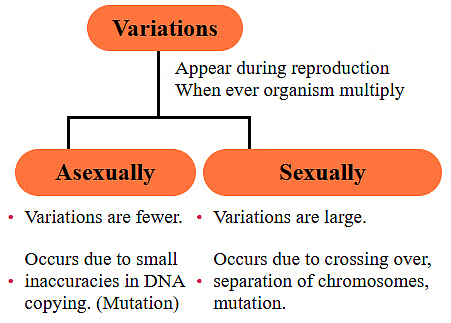Heredity and Evolution Class 10 Notes Science Chapter 8
| Table of contents |

|
| Accumulation of Variation During Reproduction |

|
| What is Heredity? |

|
| How do These Traits Get Expressed? |

|
| Sex Determination |

|
When living things reproduce, they make new individuals that are mostly like their parents but with some differences. Even though asexual reproduction (where only one parent is involved) can create a few differences, sexual reproduction (where two parents are involved) leads to many more variations. For example, sugarcane plants in a field look very similar, but animals and humans, which reproduce sexually, show a lot of different traits.
In this chapter, we will learn how these differences are created and passed on to the next generation.

Accumulation of Variation During Reproduction
- Basic Design Inheritance: Offspring inherit a basic body design from their parents or we can say that parents pass the basic structure to their offspring.
- Changes: Each generation has some small changes compared to the previous one.

- Next Generation Differences: When the second generation reproduces, their offspring will inherit traits from the second generation.
- New Variations: Each new generation also develops new differences naturally.
For example, in asexual reproduction: If a bacterial cell divides and creates new cells over two generations, there will be only tiny differences between them. These small changes happen because of slight mistakes in copying the DNA.
 Division in bacterial cells over two generations
Division in bacterial cells over two generations
Note: Small mistakes in DNA copying can lead to variations, but when sexual reproduction occurs, it creates even more diversity.
Do all the different variations within a species have the same likelihood of surviving in their environment?
- Not all variations within a species have equal survival chances in their environment.
- Survival depends on the specific traits of each variation.
- For example, heat-resistant bacteria are more likely to survive during a heat wave.
- Environmental factors select for certain traits, which is a key part of evolution.
What is Heredity?
Heredity is the process of transferring characteristics from parents to offspring through reproduction. It explains how traits like skin color, hair type, eye color, and height are passed from one generation to the next.
Let's study the rules of Heredity in detail:
1. Inherited Traits
Traits are features passed down from parents, such as eye or skin color.
- Genetic Variation: Offspring may inherit traits in various combinations based on the genes responsible.
- Example: If a parent has brown and black eyes, the child might inherit brown, black, or a mix of both eye colors. This results in variations while retaining basic features.
- Earlobe Example: If both parents have free earlobes, their children are more likely to have free earlobes, suggesting that earlobe type is inherited according to certain rules.
 Attached and free ear lobe
Attached and free ear lobe
2. Rules for the Inheritance of Traits- Mendel’s Contributions
Gregor Johann Mendel, often referred to as the 'Father of Genetics,' made significant contributions to our understanding of how traits are inherited. Through his experiments with pea plants, Mendel developed key principles that form the foundation of modern genetics.
- Pea Plant Experiment: Mendel studied pea plants with different traits, such as seed shape (round or wrinkled) and plant height (tall or short). He began by crossing plants that differed in only one trait, such as height.

(a) He crossed pea plants on the basis of one trait (height) (e.g., a tall plant with a short plant)
Single Trait Inheritance (Monohybrid Inheritance): Through his experiments with pea plants, Mendel developed key principles that form the foundation of modern genetics.

First Generation (F1): When Mendel crossed a tall pea plant with a short one, all the offspring in the first generation (F1) were tall. This result indicated that the trait for tallness was dominant over the trait for shortness.
Second Generation (F2): Mendel then allowed the F1 plants to self-pollinate. In the second generation (F2), he observed that while most of the plants were tall, a few were short. This result showed that both traits (tall and short) were inherited, but tallness was dominant.
Mendel’s Conclusion: From these observations, Mendel concluded that each trait is controlled by two copies of a factor, now known as genes. These copies can be identical or different, depending on what the parents pass on to their offspring.
Genotype and Phenotype Ratios
Genotypic Ratio: In the F2 generation, Mendel found that the ratio of different genetic combinations (genotypes) was 1:2:1. This means that for every four plants, one was homozygous tall (TT), two were heterozygous tall (Tt), and one was homozygous short (tt).
Phenotypic Ratio: The ratio of physical appearances (phenotypes) was 3:1. This means that three out of four plants were tall, and one was short. This ratio is an example of monohybrid inheritance, where a single pair of alleles determines a specific trait.

(b) He crossed pea plants on the basis of two traits: shape and color of seeds.
Pea Plant Experiment with Two Traits: In one experiment, Mendel crossed pea plants that differed in two traits—seed shape (round or wrinkled) and seed color (yellow or green). Two Trait Inheritance (Dihybrid Inheritance) is the inheritance of two traits simultaneously, leading to the concept of dihybrid inheritance.

Example: When Mendel crossed a plant with round yellow seeds (RRYY) with one having wrinkled green seeds (rryy), all the F1 offspring had round yellow seeds (RrYy), showing that round shape and yellow color were dominant traits.
F2 Generation: Mendel allowed the F1 plants to self-pollinate. In the F2 generation, he observed a variety of combinations of seed shapes and colors. The phenotypic ratio in the F2 generation was 9:3:3:1, meaning there were 9 round yellow seeds, 3 round green seeds, 3 wrinkled yellow seeds, and 1 wrinkled green seed.
Conclusion: Mendel concluded that different traits are inherited independently of each other, following the principle of independent assortment. This concept is now known as dihybrid inheritance, where two pairs of alleles for different traits are passed on independently.
How do These Traits Get Expressed?
- Traits, like how tall a plant grows, come from something called DNA in each cell. DNA is like a set of instructions for making proteins, which are important for different functions in the body. Each part of DNA that tells the cell how to make a specific protein is called a gene.
- Let’s use plant height as an example. Plants have a hormone that helps them grow. How tall a plant gets depends on how much of this hormone it makes. The gene responsible for making the enzyme (a type of protein) that helps produce this hormone affects how well the hormone is made.

- If the enzyme works well, the plant grows tall. If it doesn’t work well because of a change in the gene, the plant will be shorter.
- When plants or animals reproduce, they get half of their genes from each parent. This means that each parent contributes equally to the traits of their offspring.
- Every cell in the plant or animal has two copies of each gene, one from the mother and one from the father. However, cells that are used for reproduction (like eggs and sperm) only have one copy of each gene.
- When these reproductive cells come together, they combine to create a new organism with two sets of genes, one from each parent. This process ensures that the new organism has the right number of genes and traits.
Traits are determined by proteins made from genes, and the way genes are passed from parents to offspring explains why the offspring have certain traits. This process of passing on traits happens in all organisms that reproduce sexually, and similar rules apply to those that reproduce asexually.

Sex Determination
Sex determination in organisms can vary based on different mechanisms:
- Temperature-Dependent Determination: In some reptiles, the temperature at which the fertilized eggs are incubated influences the sex of the offspring.
- Environmental Influence: In snails, sex can change based on environmental factors.

Sex Determination in Humans: In humans, sex determination is primarily governed by genetics:
Chromosomes and Traits:
- Humans have 23 pairs of chromosomes.
- 22 pairs are responsible for determining various traits.
- The 23rd pair, known as sex chromosomes, determines the sex of the individual.
Sex Chromosomes:
- Females have two identical X chromosomes (XX).
- Males have one X and one Y chromosome (XY).

- Maternal Contribution: During reproduction, the mother always contributes one X chromosome to the child.
- Paternal Contribution and Sex Outcome:The sex of the child is determined by the chromosome inherited from the father.
If the father provides an X chromosome, the resulting XX pair will produce a girl.
If the father provides a Y chromosome, the resulting XY pair will produce a boy
|
85 videos|437 docs|75 tests
|
FAQs on Heredity and Evolution Class 10 Notes Science Chapter 8
| 1. What is heredity and why is it important in biology? |  |
| 2. How do traits get expressed in an organism? |  |
| 3. What is the significance of sex determination in heredity? |  |
| 4. How do variations occur during reproduction? |  |
| 5. What role do dominant and recessive traits play in heredity? |  |

|
Explore Courses for Class 10 exam
|

|



















